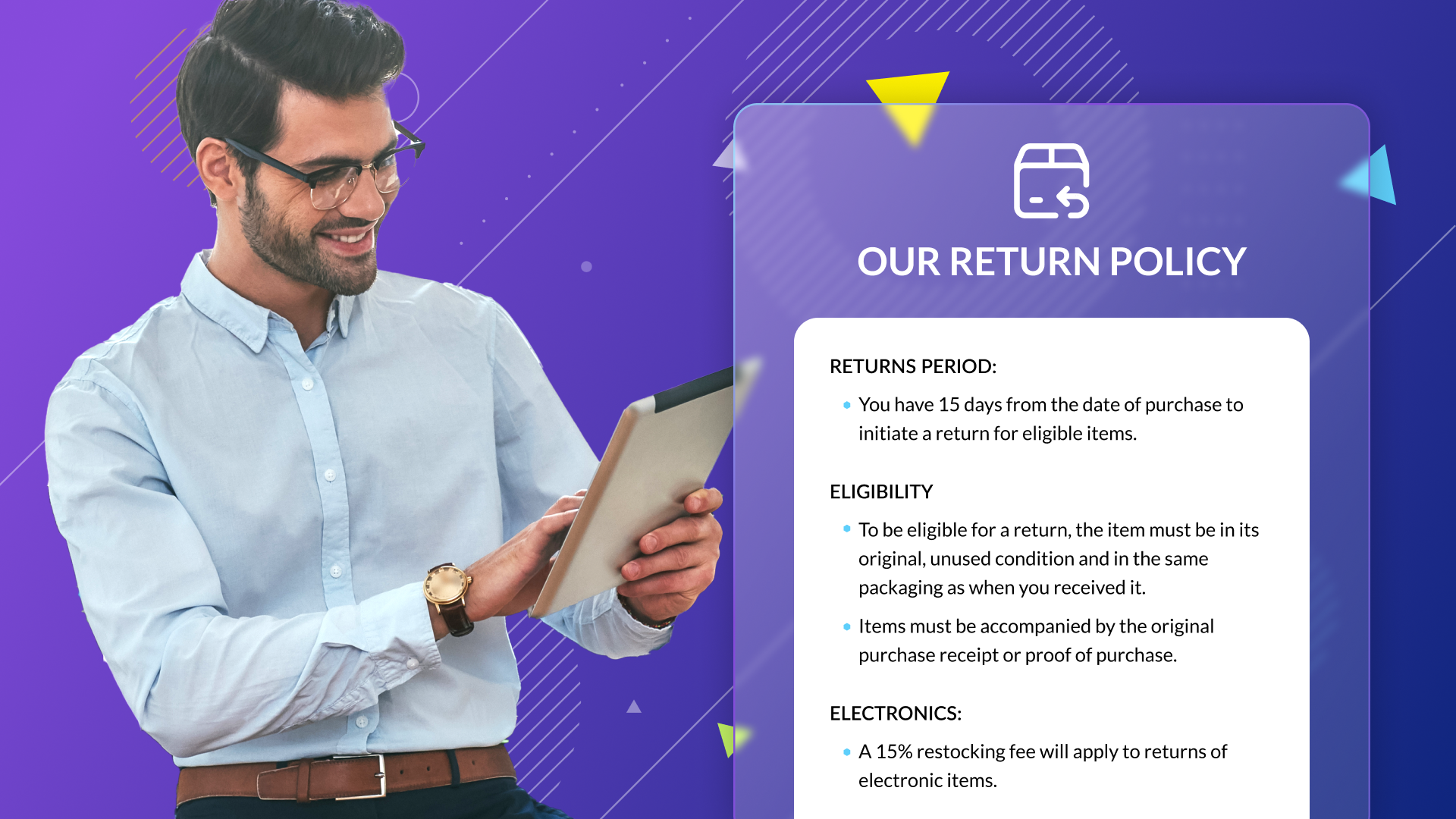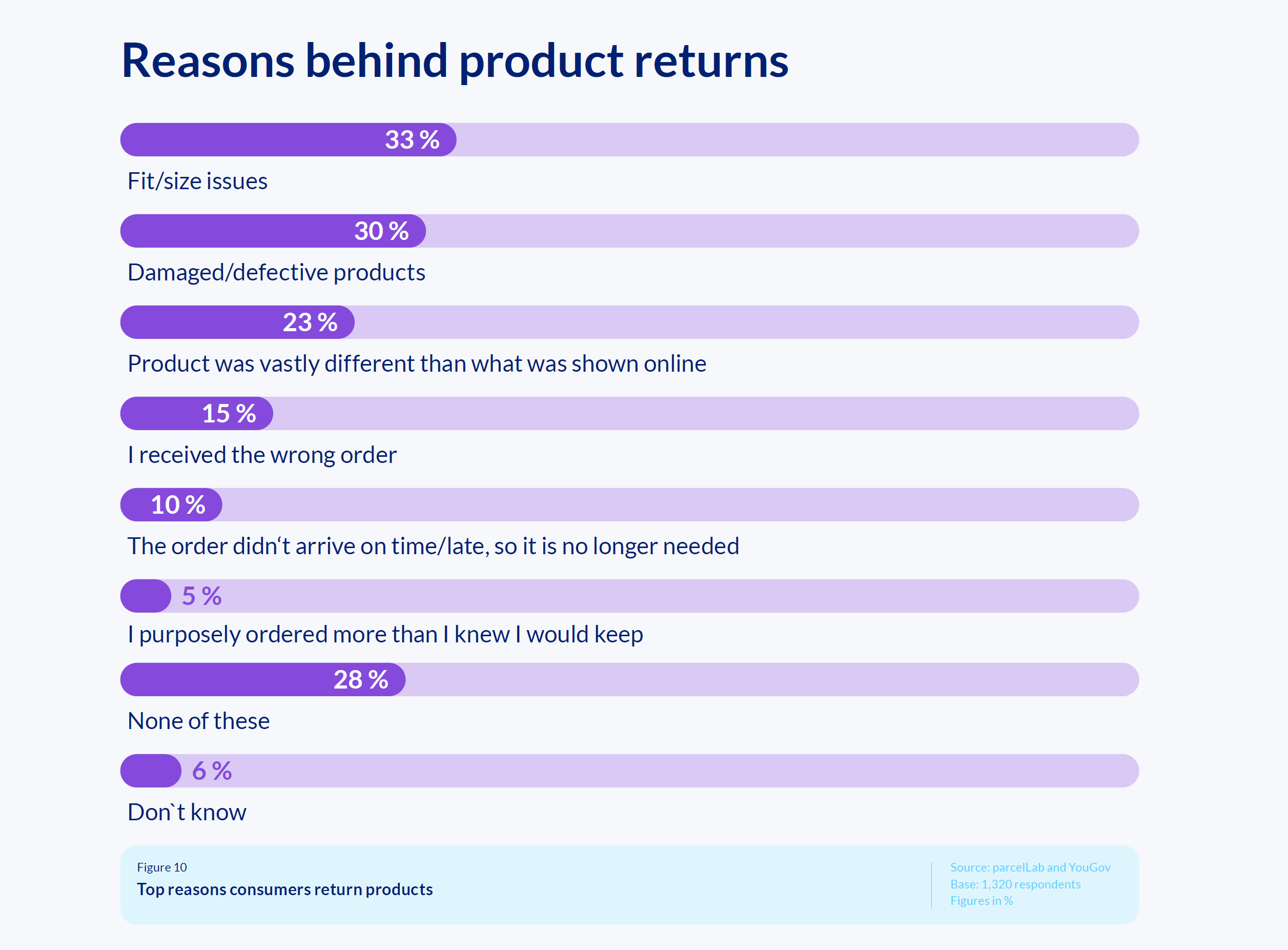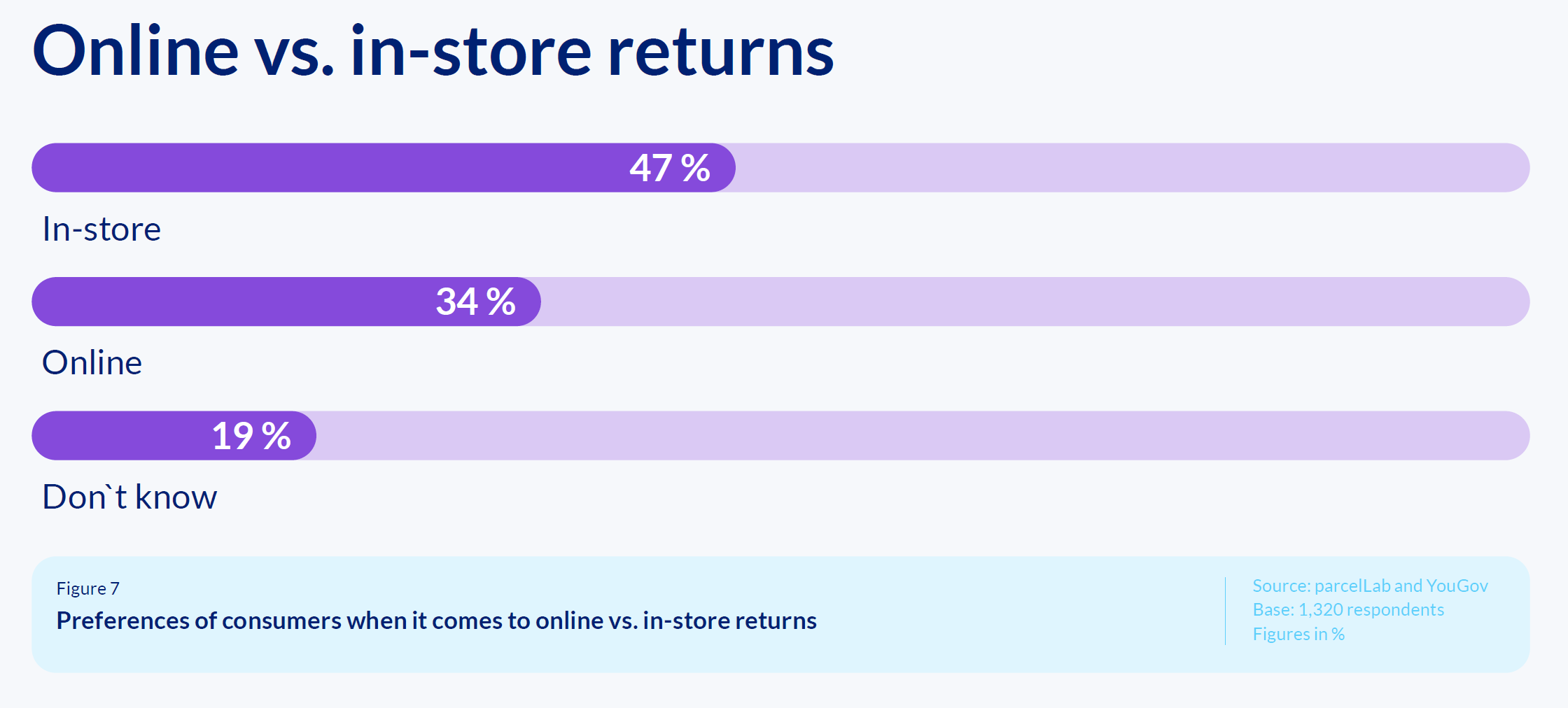Ecommerce returns are a headache for pretty much any retailer. And while there are several things you can do to minimize returns, they will always be part of running a retail or ecommerce business.
That’s why it’s essential to have robust policies and procedures for handling ecommerce returns. When managed properly, returns can provide opportunities to drive conversions and loyalty, especially when you implement returns marketing.
In some cases, they can also serve as valuable touchpoints for gathering customer feedback and making data-driven improvements.
For these reasons, you must ensure that your ecommerce operations and teams are equipped with solutions to stay on top of returns.
Read on to learn how to do just that.
Common reasons for customer returns
To effectively handle returns, we must understand why they happen in the first place. In a survey conducted by parcelLab and YouGov, we found that fit and size issues are the most common reasons behind returns, accounting for 33% of respondents’ answers.
Product damages and defects (30%) are the second most common reason behind returns. Almost a quarter (23%) of respondents said they’ve returned a product because what they received vastly differed from what was shown online.
These numbers tell us that returns often stem from quality issues and unmet consumer expectations. And while you should strive to remedy these challenges, you should also have a solid system in place for handing returns if and when they happen.
Methods for handling returns
There are several methods and channels to handle returns. Depending on your business, you can choose to accept returns in-store, online, or both. Our advice is to give consumers the option to return across online and offline channels. In other words, you should implement omnichannel returns.
Our research shows that nearly half (47%) of consumers want to return online orders in-store, while 34% prefer to do it through online channels. This suggests that there’s no one clear winner as far as returns channels are concerned, so it’s best to cover your bases.
Let’s look closer at the different channels you can use when accepting and processing ecommerce returns.
In-store returns
Implementing in-store returns means allowing customers to return their online purchases in-store. Retailers with brick-and-mortar locations typically implement this return method.
Here’s how in-store returns work:
- Customers head to the store to return their items.
- Store teams inspect the items, and depending on the condition of the goods, they may be put back on the shelf, refurbished, or disposed of.
It’s worth noting that you may still be able to implement in-store returns even if you don’t have a physical store. Consider teaming up with a brick-and-mortar retailer or another facility that can handle in-person returns.
Amazon, for example, allows customers to return items in select Kohl’s locations.
Warehouse returns
Warehouse returns take place when customers send back their orders via mail. Here’s how it works:
- Customers initiate the return process online, usually by logging into their account and following the steps outlined in the return policy.
- Upon approval, customers receive a Return Merchandise Authorization (RMA) number and a prepaid shipping label via email or directly in their online account.
- Customers package the items securely, affix the shipping label, and drop off the package at a designated carrier location.
- Once the returned items arrive at the warehouse, they undergo inspection to assess their condition. The items may be restocked, refurbished, or disposed of depending on the condition.
- After the inspection, customers are notified of the status of their return, and any applicable refunds or exchanges are processed accordingly.
Outsourced logistics
Ecommerce returns have multiple moving parts and can be quite complex, especially if you have a large and distributed customer base. That’s why some merchants use third-party logistics companies that can handle returns for them.
Outsourced returns management means teaming up with a Third-Party Logistics (3PL) provider that specializes in handling the various aspects of the returns process. This can include everything from receiving and inspecting returned goods to restocking, refurbishing, or disposing of items.
The importance of a return policy and setting clear returns guidelines
Whatever your process is for handling returns, you need to ensure that it’s backed by a solid returns policy. Ironing out your policy and setting clear guidelines are crucial for several reasons.
A good returns policy promotes trust and transparency
Clearly stating your return policy establishes transparency, which builds trust between you and your customers. People are more likely to purchase from you if they know they have a hassle-free experience.
Ensure compliance
Be aware of consumer protection laws around returns, and make sure you adhere to them. Having a well-documented returns policy that complies with the necessary regulations can help you minimize legal and regulatory risks.
It makes you more efficient
Having a well-documented policy will guide your team in handling returns so they can manage returns efficiently. A good policy also ensures consistency in how returns are dealt with, regardless of who takes care of them.
A returns policy can influence purchase decisions
Our research at parcelLab shows that 92% of respondents say a brand’s returns policy sways their purchase decisions at least some of the time. This means that your returns policy isn’t just a backend consideration; it’s an important customer-facing tool. And when you have a good returns policy in place, customers may be more inclined to buy.
| Return policy section | Description |
|---|---|
| Timeframe | Specify the time within which returns can be made. |
| Condition | Describe the condition the product must be in to be eligible for return |
| Refund process | Outline whether you offer refunds, exchanges, or store credit. |
| Return channels | Indicate where and how products can be returned. |
| Procedures | Walk customers through the process of initiating a return. |
| Exceptions | Clearly state any exceptions or items that are not eligible for return. |
What to include in your returns policy
Now that we’ve tackled the benefits of a returns policy, let’s discuss what it should look like. Generally speaking, a good returns policy outlines the following:
Time frame for returns
Specify the time frame for when returns can be made. What is your return cut-off time? Many retailers set a time frame of 30 or 60 days, while others are more lenient. Zappos, for example, is famous for its 365-day returns policy.
Note that you can adjust your time frames depending on the product. It’s not uncommon for brands to have a different policy for high-value items like jewelry or electronics.
You can also adjust your policy depending on the time of year. Many retailers expand their returns cut-off during the holiday season. That’s because this is a period when many purchases are made as gifts. Extending the return window accommodates the gift-receiver, who might not have the opportunity to evaluate the gift until the holiday is over.
Product condition
Your returns policy should also have guidelines around the condition in which products can be returned. Should they be returned in their original packaging? How will you determine if something is used or worn? Make sure you establish your eligibility criteria to avoid issues down the road.
Refund process
Outline how refunds (or lack thereof) are handled. If you’re issuing refunds, specify how long it’ll take and the method by which customers can expect the funds. If you’re not offering refunds, your policy must also state that and indicate that you’ll only be allowing exchanges or issuing store credit.
Return channels
Ensure your policy sheds light on the methods and channels customers can use to return their products. If you’re accepting online returns to your warehouse (or 3PL’s facilities), indicate who is responsible for shipping costs.
Returns procedures
In line with the section on returns channels, it’s also helpful to outline the steps customers should take to ensure a smooth returns process. What actions should they take to initiate a return? How can they obtain the necessary information or documents (like shipping labels) to return their purchases?
Exceptions
Finally, if you have products that aren’t eligible for returns, specify what those items are so customers know that they’re purchasing something that’s final sale.
Best practices for handling returns
If you’re at a stage in which you’ve ironed out your return methods and have a solid policy in place, the next step is to optimize the returns processes. While the experience will vary depending on your business and any partners you’re working with, you’ll want to consider some general best practices.
Determine the best return shipping and label options
When it comes to online returns, retailers can use either shipping labels or QR codes (sometimes both). These methods have their advantages and disadvantages. Consider the following.
Shipping labels
Shipping labels are best for retailers wanting a more traditional online returns experience. These labels are straightforward and well-understood by most consumers. All they need to do is attach the label to the package and drop it off at the designated carrier location.
By providing prepaid labels, you get to choose the carrier and shipping service, allowing you to negotiate rates and choose the most cost-effective and reliable option.
Additionally, prepaid labels mean the customer doesn’t have to worry about paying shipping fees upfront, which can enhance the customer experience.
QR codes
With a QR code, the customer doesn’t need to have access to a printer. They simply present the QR code at a drop-off point, where it is scanned, and a label is printed for them.
QR codes can also be a more sustainable option and are convenient for tech-savvy shoppers. Customers can store the QR code on their mobile device, making it simple to initiate the return when they’re near a drop-off point.
What’s more, QR codes can hold more information than a traditional label, such as the reason for the return, which can be helpful for processing.
Whether or not you should use QR codes or shipping labels depends on your returns processes and customers. Whatever you decide, make sure your returns and post-purchase can support your methods.
parcelLab’s returns and warranty platform offers powerful capabilities that enable you to implement a streamlined returns experience.
With parcelLab Retain, you can allow your customers to select items for returns, choose a convenient returns method, and get a label or QR code with an embedded, personalized returns experience.
Streamline the return requests process using self-service returns
To truly offer a seamless experience, consider implementing self-service returns. Rather than requiring customers to email or contact your support team, let them do it all themselves using a branded return portal.
Doing so helps unlock advantages for both you and your customers.
Self-serve returns are more convenient
Self-serve portals make the returns process faster and more efficient, increasing customer satisfaction. Customers appreciate the convenience of initiating a return on their own time without interacting with customer service. Plus, a self-serve portal is accessible 24/7, so customers have more flexibility around when they initiate a return.
From a business operations perspective, a standardized, automated process ensures that all returns are handled consistently, reducing the likelihood of errors or discrepancies.
It frees up your customer support resources
Implementing self-serve returns also reduces the burden on your customer service team. This allows them to focus on more complex issues that require human intervention.
You’re able to collect more data
Self-serve portals can also be designed to collect data on why customers return items. This information can be invaluable for identifying trends, improving products, and tailoring future marketing efforts.
Keep your customers in the loop
Another vital component of returns management strategy lies in post-purchase communications. Just as you would proactively communicate tracking updates and send shipping notifications when customers make a purchase, you should also extend the same level of diligence to the returns process.
Here are some tips on how to do just that.
Provide regular updates
Keep customers in the loop at every stage of the return process. Providing transparency during this stage gives customers peace of mind and helps build trust.
In line with that, using branded emails and messages is also beneficial when sending return-centric communications. Rather than a generic-looking email, send a message that’s aligned with your brand’s look and feel. That way, you maintain brand consistency and reinforce your brand identity throughout the customer’s journey, even during the returns process.
Allow customers to track returns
Empower customers to track the journey of their package back to your warehouse or 3PL. Send them tracking info on their return so they can see where the goods are. This helps set the right expectations, particularly when it comes to their refund. It also frees up your team from having to deal with WISMR (Where is my return?) inquiries,
For best results, allow them to track returns using a branded self-serve portal so you can provide a consistent experience.
Keep customers updated on the status of their refund
Keeping customers updated on the status of their refund adds a layer of transparency that builds trust and enhances the overall customer experience. Timely notifications about the progress of their refund process not only keep customers informed but also reduce the likelihood of anxious follow-up queries so your team isn’t bombarded with refund issues.
Gather returns data and feedback
The best way to improve your returns process (and overall shopping experience) is to collect data and input from your customers. It’s helpful to know:
- Why they’re returning a product
- How they feel about the customer experience
- The ease and speed of the return and refund process
- What they think about the returns or shipping options
- How your process compares to other retailers
Understanding these factors allows you to spot areas of improvement so you can make changes and enhance the post-purchase journey even more.
Final words
Returns can be challenging to deal with, but there are several steps you can take to streamline the process for both your business and your customers. Start by having a solid policy and ensure your operations are backed with robust tools and technologies that can simplify the returns experience.
Throughout the returns journey, make it a point to communicate with your customers to provide transparency and peace of mind.
Learn more about how to transform your returns experience in our new guide.
FAQ
Ecommerce returns refer to the process of customers sending back products they’ve purchased online. Depending on your business, returns can be initiated online and sent back via mail. In some cases, returns can also be accepted and processed in-store.
The most common reasons behind returns include:
- Fit/size issues
- Damaged/defective products
- Products are not as described
- Customers received the wrong order
- Orders didn’t arrive on time
Depending on the retailer, returns can be handled in the following ways:
- In-store returns
- Warehouse returns
- Outsourced logistics
Written by



